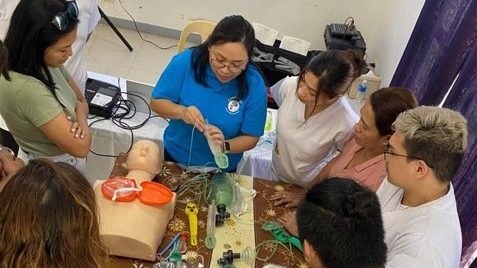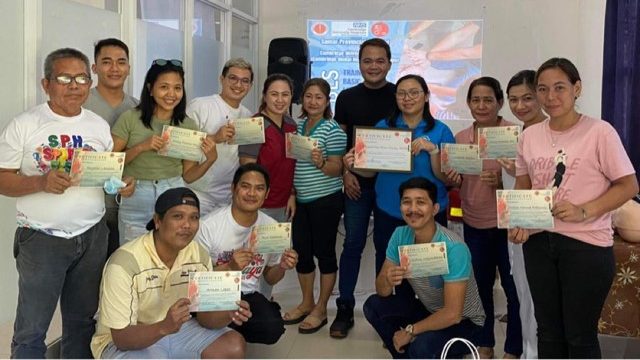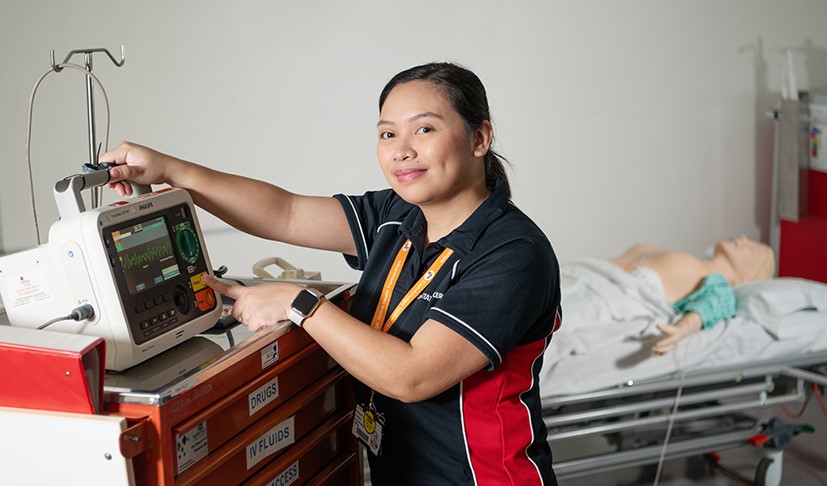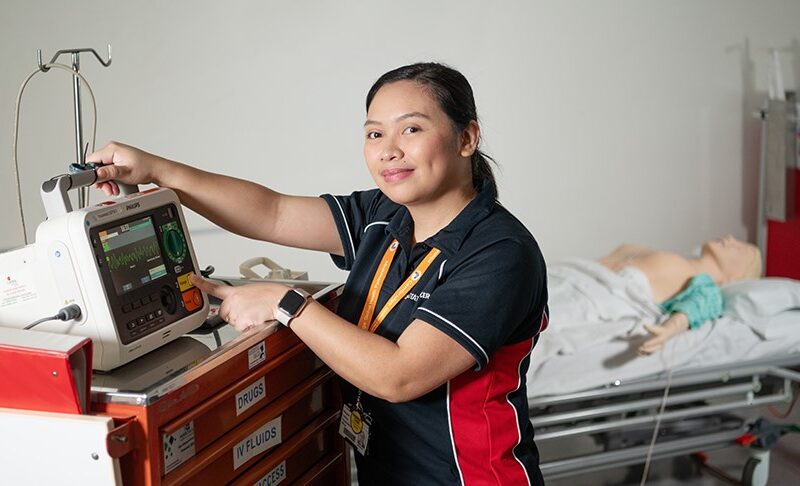By Margaret Baron-Catuday
In this blog, resuscitation officer and educator Margaret Baron-Catuday explains how she’s helping to build staff knowledge and best practice for managing emergencies at Samar Provincial Hospital in the Philippines, while growing her own confidence as an educator.
Originally from the Philippines, Margaret Baron-Catuday is a CGHP member and resuscitation officer at Addenbrooke’s Hospital. In 2020, she volunteered through CGHP to conduct a workshop for nurses on the management of the deteriorating patient at Samar Provincial Hospital in her family’s hometown. After keeping in touch throughout the Covid pandemic, she returned in January this year to reinforce the learning with a one-day training workshop.

Background
Samar Provincial hospital (SPH) is a 100-bed tertiary hospital in Catbalogan, Western Samar. It is the major health facility for the whole of Western Samar, which has a population of more than 790,000. During my previous visit, I established that SPH didn’t have a full emergency kit and the kit they did have included a defibrillator that nobody had been trained to use. My focus on this visit was therefore to provide training on the management of a deteriorating patient and an airway workshop, as well as delivering an Emergency Grab Bag donated by Cambridge University Hospitals Trust (CUH) and providing expert advice on the maintenance of their emergency equipment.
What did you do during the visit?
Before the workshop I met the hospital’s training officer to make sure we had all the equipment needed and to discuss recommendations for the chief of hospital. We also had a walk around the hospital to check on the emergency equipment.
During the training I learned that there are many cardiac arrests in-hospital and out of hospital, that the survival rate is low, and that there isn’t a specific audit report for these events. Part of the reason for this is a lack of training, especially around the emergency equipment. The defibrillator in the hospital has only been used once by a medic and must be plugged to the main electricity source, and the resuscitation trolley isn’t well stocked and regulated. The training officer and I removed expired items, recommended using a content list, and advised switching to an Automated External defibrillator (AED) as it is portable, battery-operated and easier for the rest of the staff to use.


How did your visit impact the local staff?
31 people attended the workshop, including Emergency Department nurses, nursing assistants, Allied Health Professionals, and ambulance drivers. They learnt the basics in managing a cardiac arrest event and the ABCDE approach in the management of a rapidly deteriorating patient. We also reinforced that calling for help early and not working in isolation is key.
Being able to donate the Emergency Grab Bag meant we were able to teach them how to use every single item inside it. We put emphasis on only working within their skill set and what they are licensed to do.
After the training, the attendees felt more confident and expressed readiness to respond to emergencies. They were fully engaged in performing basic life support and early defibrillation during the simulation and felt more equipped to deal with cardiac arrest or rapid deterioration events afterwards. The training officer now has training kits that she can use to refresh their skills regularly.
I will never forget the sight of the nursing assistants and ambulance drivers sitting at the very back of the room for training, and then walking away after the training standing tall and proud of themselves, taking pictures with the manikins, after performing high quality CPR and safe defibrillation. Now they can be valuable members of the cardiac arrest team when it happens.
Did you support or enable any changes to service provision?
There was a shared understanding between me and the training officer about how the current emergency kits may impact patient safety. For example, the resuscitation trolley doesn’t get checked on a regular basis and there is no emergency folder to mandate what needs to be in the trolley. Their go-to emergency cabinet is monitored more regularly, but in an emergency, staff must go back and forth to get what they need.
Given the layout of the hospital, I recommended using a portable emergency bag and suggested they get an automated external defibrillator to store in it. I suggested they create a core group of emergency responders who can attend emergencies because every nurse is already attending to a large number of patients.
The project was an eye opener for the hospital administration and allowed them to see how their emergency equipment and specifically a kit bag could be improved. They realised the importance of making mandatory advice for their kit so that it is fit for purpose when needed.
What was the biggest difference or surprise about the healthcare setting you were working in?
At CUH, no clinical space would be able to operate without resuscitation services assessing the emergency equipment required in their setting. We are robust with standardising equipment, and we monitor them on a regular basis. We also ensure that staff groups know how to use the equipment given to them. For example, when we launched a new defibrillator, we had to train at least 80% of staff before it was deployed to clinical areas.
At SPH, emergency equipment is less structured with no standard operating procedures in the management and maintenance of it. This means they’re not as prepared and confident as they could be in the event of patients deteriorating. Although they maintain a close relationship with the regional hospital, this is two hours away, and therefore immediate management often needs to be done at SPH.

How has the visit impacted you personally?
As a CGHP volunteer, I feel very accomplished with what I have offered to do, knowing that the population of Western Samar have a better chance of receiving quality care from Samar Provincial Hospital. Samar is my family’s hometown and by immersing myself in the local hospital as an educator, I may be able to improve the care that they and everyone else receives at SPH.
I can vividly recall attending a CGHP event few years ago, where another member said to me; “as volunteers, we truly get more than what we give”. I have always thought that the projects I do are simple initiatives and a modest giving-back gesture. He made me appreciate the impact I am making to global health. It feels really rewarding to be able to do this, especially for my home country.
Of the people you met who will you remember most and why?
The training officer – she is passionate about what she does and eager to make things better -but this project will be a big challenge for her on top of her existing workload.
At CUH, we have eight resuscitation officers to ensure safety related to resuscitation. At SPH, there is one training officer who also does a variety of other trainings and is mainly focused on new staff. Refresher courses are typically done by private training institution, which comes with a cost and isn’t widely available to most patient-facing staff.
I shared CUH best practice with her and advised how other staff members could mentor or serve as practice development educators in clinical areas. I recommended how to organise in-house training activities to better share the learning from the staff who’ve been able to attend external training.
What’s next?
The key message was ensuring the hospital invests in education and training, so there is a robust system in place in maintaining emergency equipment and improving patient safety. The next step is for SPH to realign and revisit their operations, as well as personalising the emergency equipment to make it most useful for them.
Through the training officer, I will continue to provide advice as needed in the management of their emergency equipment and I hope to review and evaluate how they’re getting on in three months’ time.

CGHP’s Grant Scheme is open to staff members from Cambridge University Hospitals and the wider Cambridgeshire healthcare community who are undertaking a voluntary healthcare placement with a low- and middle-income country. Find out how you can apply.
Return to blogs

